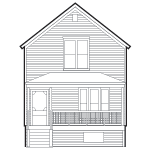
Workers cottage with double addresses, renumbered to 843 N. Monticello Ave in 1909. Courtesy Logan Square Preservation.
What's the History of Your Cottage?
Researching the history of your house and learning about past residents can bring new appreciation for an older home. It can be more challenging to find documents telling the story of a smaller house built for humble residents than larger homes built by wealthy families. Most workers cottages were designed by carpenters and craftsmen rather than architects. Building plans for cottages and other simple houses were likely just rough drawings and most likely not saved after the house was finished. With a bit of luck and patience you may turn up some interesting stories or even photos of your house from long ago.
Old House Numbers
Many of Chicago's house addresses were reorganized in 1909. Look carefully at the cottage in the image above and you'll see both old number (406) and new number (843) posted on the door during the time of transition. Because most workers cottages were built before 1909, its likely that your cottage was originally known by a different address. The street may have changed its name over time as well. Two guides hosted by the Chicago History Museum convert Street Re-Numbering and Street Re-naming to previous addresses. In the case of the photo above, the Street Re-Numbering guide shows columns of new and old addresses, with old #406 N. Monticello converted to new #843 N. Monticello Ave.

Take note of the old addresses of the houses next door, as well as any old names of nearby cross streets. These will be important when searching newspaper archives.
Finding Building Permits
UIC's online Chicago Building Permits Digital Collection features scans of microfilms of building permit books which have since been lost. Start by looking up the address in the alphabetical street index. You can jump ahead in each microfilm reel by entering a page number at the top of the screen. If the scan is difficult to read, experiment with the Settings at the top of the screen to adjust brightness and contrast, or click the Enhance button on or off. The Download button lets you save the image.
If the card is impossible to read, or doesn't exist for your address, you may still be able to figure out what year the house was built from newspaper archives or property records.
In the example below, building permit #1362 for the cottage at 843 N. Monticello Ave (old address 406 Tinkham) in Humboldt Park was issued April 22, 1890.

Go back to the home screen of the Building Permits Collection to access the Building Permit Ledgers microfilms to find the building permit by date. Permits for some years are divided into north or south or other areas of the city. More than one area may be on the same microfilm reel, so you may have to jump forward or back on the reel to find where one area's permits end and another's begin. The building permit number can help find the right section and page of the microfilm, especially if the date on the index card is illegible. Finally on page 153 we find building permit #1362 for 406 Tinkham (843 N Monticello):

Zoom in to read the small print and use the Scissors to crop the image to a smaller area before saving the image for your records. In our example, building permit #1362 was issued to owner H. Hartman for building a 1-story 20' x 34' cottage.

Street Maps
Fire insurance maps are a great resource for finding clues about changes to buildings. With a Chicago Public Library card you can search scans of fire insurance maps. From the initial page, find the rough location on the satellite map or type the address in the search bar at the top. If you don't have a Chicago library card you can find many of these same maps on the Library of Congress website. Study the Key on the first page of the insurance map to interpret the various colors and symbols which indicate building materials, footprint, height and other info. You can compare maps from different years to find clues about changes to the buildings in between.
As an example, the house at 843 N Monticello Ave appears below on the 1896 Sanborn fire insurance map identified by the old address of 406 N Monticello. The symbols on the map indicate that it is a 1-story dwelling with 8-inch thick brick walls, a wood cornice and a wood-shingle roof. In back by the alley there was a small 1-story frame dwelling with asphalt shingle roof. There were several other similar cottages a few lots to the north and south, which we might wish to investigate later to compare:

By the time of the 1922 insurance map below, our house had a new address of 843 N Monticello, a wooden (yellow) addition at the rear of the house and a new asphalt shingle roof. The small wood porch in front which appears in the photo at the top of the page may be a post-1896 addition as well. The 1-story building near the alley may be the same dwelling from the 1896 map, or a new wooden shed. On the empty lot to the south was a larger garage for an automobile. As we'll find out in the property record research below, this lot was a side yard belonging to the owners of the cottage at 843, so the auto garage shows that the family owned a car by this time.

The Sanborn company updated this map after 1922 by pasting small pieces of paper over the original to reflect changes to the buildings. The updates on this particular map continued until 1949. The rear addition is now marked as made of brick. Either the 1922 version was colored incorrectly, or the wood addition was replaced by brick in the same footprint. The wooden building near the alley was enlarged or replaced by a new auto garage replacing the older garage on the lot to the south. The brick 2-flats built north of the cottage after 1922 must have made the cottage seem boxed-in after three decades of looking out the window at grassy empty lots.

Comparing the changes in insurance maps over time can show a wide variety of changes to the individual house as well larger changes to the whole street.
Digging into Property Records
To research the house's past ownership you'll need to find the legal description of the property. You can look up the PIN (property identification number) and basic characteristics about the house and property on the Cook County Assessor website.
The Cook County Recorder of Deeds website lists mortage and deed documents online dating from 1985 to the present. These documents typically include the legal description of the property, which identifies the lot and block number, name of the subdivision, and section, township and range:

Property records older than 1985 are not online, but are recorded in hand-written ledger books in the Tract Department in the basement of the Cook County Clerk Department at City Hall. To find your property at the tract department, first look for one of the large index books sitting on the top of the cabinets. The index book lists subdivisions in order by section-township-range. The page for each section will direct you to the ledger book for each subdivision. In this example of page 2-39-13 shown below, there are several Diven's subdivisions, but the one matching the legal description above directs us to tract ledger book #102-B.

Find the property ledger books on the low shelves throughout the room. Many ledger books have a table of contents to direct you to the start page of each subdivision, which often includes a survey map which can help double-check that you are looking for correct lot number on the correct block.
The ledger lists all legal transactions related to the property starting from when the land was subdivided into lots. Deed transfers listed in the "Instruments" column show changes of ownership, while other transactions listed may include mortgages or other financial exchanges and legal claims for the property. Staff at the tract department can provide you with a list of abbreviations used on the ledgers to help understand the property's history.

The six- or seven-digit number in the left column refers to documents with additional information about each transaction. These are most often on microfiche stored in another room at the Tract Dept. The process for retrieving these microfiched files can be cumbersome and time-consuming. Usually there is enough information in the ledger book alone to piece together the story of the property.
Keep in mind that the ledger is a record of land ownership, not a record of building permits. Some properties may have changed hands by real estate speculators several times before a house was built there. In this example, Thomas J. Diven sold a warranty deed for lot 41 to Herman Hartman on October 19, 1888. Diven sold Lot 40 (the next lot to the south) to Darius H. Bartlett in 1887, but as we've seen previously in the fire insurance maps, Bartlett never built a house on it. Instead Bartlett and his wife sold the empty lot to Wayland Leighton in 1895, who sold it back to Della Bartlett in 1902 who finally sold it to the Hartman family in 1904. The Hartmans sold both properties to Jacob Wieson on June 2, 1914. Even today, Lot 40 remains an open side yard connected to the cottage on Lot 41. If you are unable to find information on when your house was built, searching for owner names from the property record in old city directories might give a clue when and whether the owner might be living in a house on the property or simply held an empty lot as a real estate investment.
The staff at the tract department can make a copy of the ledger pages to save for your records.
News of the Past
Now that you've gathered the names of previous owners and old addresses, try searching for these names and addresses in online newspaper databases. You can search the Chicago Tribune, Sun-Times and Chicago Defender archives for free with a Chicago Public Library card. Subscription newspaper archives like Newspapers.com and GenealogyBank can also be accessed for free at the Newberry Library. The Library of Congress Chronicling America archive contains a great number of smaller Chicago newspapers. Google Books, HathiTrust and the Internet Archive have scans of magazines and journals. Try searching every possible variation of the names and numbers that may have been misspelled by a reporter or misread by a computer.
Searching newspapers for the old street name without a house number can sometimes turn up a record of a real estate sale or building permit for the property. In our example, searching for "Tinkham av" (with Avenue spelled the old-fashioned way) found several nearby real estate sales. Searching again for the name "Diven" from the property record turned up others.


While none of these articles refer to the exact address of our house, we might guess that Herman Hartman paid the same price for his empty lot from developer Thomas J. Diven as the $200 that J.L. Flannesy and A.M. Enk paid for their lots around the same time on the same block. A higher sale price between $1500 to $2000 might indicate that there was already a cottage on the lot built by the developer. If you are not able to find a building permit for the house, a newspaper real estate listing might give some clues to when the house was built and first sold.
Residents and neighbors
Once you've found a few names of early residents of your house in property records or newspaper articles you can search for them on FamilySearch, Ancestry or MyHeritage to find census records and other info about the families who once lived on your street. Search for the old or new address as a keyword search to find more names to connect with the address. You may wish to make a spreadsheet to track census dates and names at your address, especially if the cottage has more than one apartment.
For our house example, searching the keyword "406 Tinkham" on Ancestry found a voting registry from 1888 listing Herman Hartman living at this address. This was two years before the 1890 building permit for the brick cottage we found earlier. Therefore we might guess that the small wooden dwelling near the alley seen on the first Sanborn insurance map was a wood cottage built by the Hartman family soon after they bought the property in the fall of 1888. They likely lived in the wood building while building the brick cottage two years later.
You may find information about former residents of your house in a family tree on a genealogy website. If the tree was created by a direct descendant of the former resident, they may have photos or know more about the family. It takes a bit of detective work and luck to find someone who might have more information about your house and get a reply. In our example, a search on Ancestry found a relative of Herman Hartman who graciously shared a family photo. Herman is on the back left with his siblings, parents and nieces and nephews. The house pictured is not our house on Monticello Ave, but is likely one of the homes of his relatives in Cleveland where he grew up before marrying and moving to Chicago in the mid-1880s.

Frederick & Christine Hartman Family, courtesy Sharon Kassay
You can piece together a timeline of your house combining the property record and biographical information about past residents. Herman and his wife Minnie bought the property at 843 N Monticello about two weeks after their son Percy was born in 1888. Their oldest daughter Elsie was five and son Roy two. After the brick cottage was finished in 1890, the couple had two more children who grew up with their siblings in the house which was only about 650 square feet when first built. We might guess that, like other cottages, there was a semi-finished room in the attic where the five children slept. Herman worked as a foreman at a brass foundry. After their children were all grown, Herman and Minnie sold the house in 1914 and made a dramatic move far from Chicago to a farm near Galveston, Texas.
Finding photos or more information about the families who lived in your cottage can be hit or miss depending on what is in public records or what descendants of the family might have shared on Ancestry or FamilySearch or other genealogy sites. The families listed in property records who lived longest at your house are more likely to have a relevant photo or info than shorter-term owners.
Whether or not you have luck finding information about the families who once lived at your house, it can also be worth the time to research the houses next door as well. You might find that the long-ago neighbors were related to the residents of your house, or have a photo which shows your house in the background, like the house on the left in the Hartman family photo above. If there are other cottages near yours, they may have been built by the same builder and have a similar history. It can take extra time to research additional houses, but finding connections between long-ago neighbors can create a larger picture of what your street was like long ago.
Photos of the neighborhood
Another place to look for historic photos of your house is in museum collections. The Chicago Collections Consortium makes it easy to search digital images held by numerous Chicago institutions by neighborhood. Many photos may be identified by neighborhood only, not by address. You can search for owner names, addresses and street names in the search bar at the top to see if any photos or other documents turn up.
The Chicago History Museum has many non-digitized photographs of Chicago streets organized by street name at the Abakanowicz Research Center and the Chicago Public Library has neighborhood collections of photos and other materials at several regional locations, but these collections are not as extensive as you might think. In general the collections include more photographs of busy streets and larger houses than small cottages on side streets. You may have more luck with smaller-scale neighborhood history organizations such as the Edgewater Historical Society, Logan Square Preservation or other groups for your area. There are also many neighborhood Facebook Groups which might have more local knowledge of photo collections which might include your house.
Have you found an interesting story about the history of your workers cottage? Please share with us!





